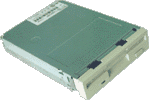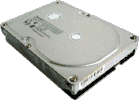Choosing a FDD and HDD
Choosing a floppy drive and hard drive(s) for your PC
Floppy Disk Drive (FDD)
Modern PCs no longer use floppy drives. The information is retained here for reference purposes.

Most Motherboards can support up to two floppy drives but one will do just fine for most PC's. As long as you buy a 'PC compatible' Floppy Drive you can't really go wrong here.
Note that some PC Cases require a FDD without the front bezel fitted.
Hard Disk Drive (HDD)

Most Motherboards can support up to 4 IDE devices (2 per IDE channel, one 'Master' and one 'Slave'). A basic PC will usually have one IDE Hard Disk onto which the Operating System and games/applications will be installed.
Reputable HDD Brands: Western Digital, Maxtor, Samsung, Seagate
HDDs are often described by the following specifications:
- From 100GB to 300GB or more
-
This refers to the storage capacity of the Hard Disk
When formatted, the Hard Disk should be able to store approximately this much data (Operating System, Programs and files.)
Note that, owing to the method by which the hard disk is formatted, the full advertised capacity will not be available for actually storing files. This is normal though, as a small amount of the space will be used by the File System.
- IDE / E-IDE / ATA / PATA or Serial-ATA
-
This refers to the method by which data is transferred between the Motherboard and the Hard Disk.
IDE / E-IDE / ATA / PATA (all mean the same thing and commonly referred to as IDE) are the most common method and supported by most Motherboards currently.
S-ATA is a relatively new, faster connection standard and support is only found on newer Motherboards.
- ATA/33, ATA/66, ATA/100, ATA/133, ATA/150+
-
This refers to the theoretical rate (top speed) that data can be transferred between the Motherboard and the Hard Disk.
Rates up to ATA133 can be achieved using standard IDE HDDs, while Serial-ATA Operating System are pushing beyond these limits to ATA/150 and above.
Note that hard disk data transfer rates depend on compatibility with the Motherboard, but thankfully are usually backwards-compatible and run at the fastest speed the Motherboard can handle.)
- 5400, 7200, 10000+ RPM
-
This refers to the spindle speed of the Hard Disk itself (how fast it spins inside.)
Higher speeds improve performance, but also tend to be noisier and get hotter in operation.
- 2/4/8/16MB Cache
-
This refers to the capacity of local memory on the Hard Drive (if any.)
The hard disk stores information in its memory, so that, if the same information is requested again, it can be read from cache memory faster than it would take to re-read it from the disk.
Larger Cache capacity can improve hard disk performance, particularly where the repeat information is constantly being accessed.